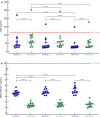Adaptive response triggered by the repeated SCUBA diving is reflected in cardiovascular, muscular, and immune biomarkers
- PMID: 33463896
- PMCID: PMC7814492
- DOI: 10.14814/phy2.14691
Adaptive response triggered by the repeated SCUBA diving is reflected in cardiovascular, muscular, and immune biomarkers
Abstract
It has been shown that one recreational SCUBA (rSCUBA) diving session is sufficient to cause changes in plasma level of cardiovascular (CV) and muscular biomarkers. To explore whether repetitive rSCUBA diving triggers an adaptive response of the CV, muscular, and immune system, we measured the cardiac damage (NT-proBNP, hs-TnI, and CK-MB), muscle damage (myoglobin (Mb), galectin-3, CK, and LDH), vascular endothelial activation (ET-1 and VEGF), and inflammatory (leukocyte count (Lkc), CRP, and IL-6) biomarkers. A longitudinal intervention study included divers (N = 14) who conducted one dive per week over 5 weeks at the depth of 20-30 m for 30 min after a non-dive period of 5 months. The blood samples were collected before and after the first, third, and fifth dives and specific biomarkers were measured in plasma or serum by the standard laboratory methods. The concentrations of the majority of measured biomarkers increased after every single dive; the exception was ET-1 concentration that decreased. The cumulative effect of five dives has been reflected in diminishing changes in hs-TnI, Mb, galectin-3, ET-1, VEGF, and IL-6 levels, and more pronounced increases in NT-proBNP and hs-CRP levels. The median values of all measured biomarkers in all time points, except Mb, remained within the corresponding reference range. Repeatedly performed rSCUBA diving activates an adaptive response of the CV, muscular, and immune system that is reflected in changes in the specific biomarker concentration.
Keywords: IL-6; NT-proBNP; SCUBA diving; endothelin-1; galectin-3; myoglobin.
© 2021 The Authors. Physiological Reports published by Wiley Periodicals LLC on behalf of The Physiological Society and the American Physiological Society.
Conflict of interest statement
The authors declare that they have no conflict of interest.
Figures





Similar articles
-
Changes in Specific Biomarkers Indicate Cardiac Adaptive and Anti-inflammatory Response of Repeated Recreational SCUBA Diving.Front Cardiovasc Med. 2022 Mar 14;9:855682. doi: 10.3389/fcvm.2022.855682. eCollection 2022. Front Cardiovasc Med. 2022. PMID: 35360010 Free PMC article.
-
Effects of recreational SCUBA diving practiced once a week on neurohormonal response and myokines-mediated communication between muscles and the brain.Front Cardiovasc Med. 2023 Mar 29;10:1074061. doi: 10.3389/fcvm.2023.1074061. eCollection 2023. Front Cardiovasc Med. 2023. PMID: 37063956 Free PMC article.
-
Galectin-3 and Cardiovascular Biomarkers Reflect Adaptation Response to Scuba Diving.Int J Sports Med. 2020 May;41(5):285-291. doi: 10.1055/a-1062-6701. Epub 2020 Jan 23. Int J Sports Med. 2020. PMID: 31975358
-
Recreational scuba diving: negative or positive effects of oxidative and cardiovascular stress?Biochem Med (Zagreb). 2014;24(2):235-47. doi: 10.11613/BM.2014.026. Epub 2014 Jun 15. Biochem Med (Zagreb). 2014. PMID: 24969917 Free PMC article. Review.
-
[Scuba diving and the heart. Cardiac aspects of sport scuba diving].Herz. 2004 Jun;29(4):406-13. doi: 10.1007/s00059-004-2581-5. Herz. 2004. PMID: 15241540 Review. German.
Cited by
-
Changes in Specific Biomarkers Indicate Cardiac Adaptive and Anti-inflammatory Response of Repeated Recreational SCUBA Diving.Front Cardiovasc Med. 2022 Mar 14;9:855682. doi: 10.3389/fcvm.2022.855682. eCollection 2022. Front Cardiovasc Med. 2022. PMID: 35360010 Free PMC article.
-
Effects of recreational SCUBA diving practiced once a week on neurohormonal response and myokines-mediated communication between muscles and the brain.Front Cardiovasc Med. 2023 Mar 29;10:1074061. doi: 10.3389/fcvm.2023.1074061. eCollection 2023. Front Cardiovasc Med. 2023. PMID: 37063956 Free PMC article.
-
Eccentric exercise-induced muscle damage and inflammation in conjunction with high-altitude decompression in adults.Physiol Rep. 2024 Dec;12(23):e70147. doi: 10.14814/phy2.70147. Physiol Rep. 2024. PMID: 39667826 Free PMC article.
-
Post-exercise creatine kinase variability: a literature review.Biochem Med (Zagreb). 2025 Jun 15;35(2):020502. doi: 10.11613/BM.2025.020502. Biochem Med (Zagreb). 2025. PMID: 40520657 Free PMC article. Review.
-
Laboratory medicine and sports: where are we now?Biochem Med (Zagreb). 2024 Oct 15;34(3):030501. doi: 10.11613/BM.2024.030501. Epub 2024 Aug 5. Biochem Med (Zagreb). 2024. PMID: 39171092 Free PMC article. Review.
References
-
- Ascensao, A. , Rebelo, A. , Oliveira, E. , Marques, F. , Pereira, L. , & Magalhaes, J. (2008). Biochemical impact of a soccer match—Analysis of oxidative stress and muscle damage markers throughout recovery. Clinical Biochemistry, 41, 841–851. - PubMed
-
- Bernat‐Adell, M. D. , Collado‐Boira, E. J. , Moles‐Julio, P. , Panizo‐González, N. , Martínez‐Navarro, I. , Hernando‐Fuster, B. , & Hernando‐Domingo, C. (2019). Recovery of Inflammation, Cardiac, and Muscle Damage Biomarkers After Running a Marathon. Journal of Strength and Conditioning Research, 10.1519/JSC.0000000000003167. [ahead of print 2019 Apr 29]. - DOI - PubMed
MeSH terms
Substances
LinkOut - more resources
Full Text Sources
Other Literature Sources
Research Materials
Miscellaneous

